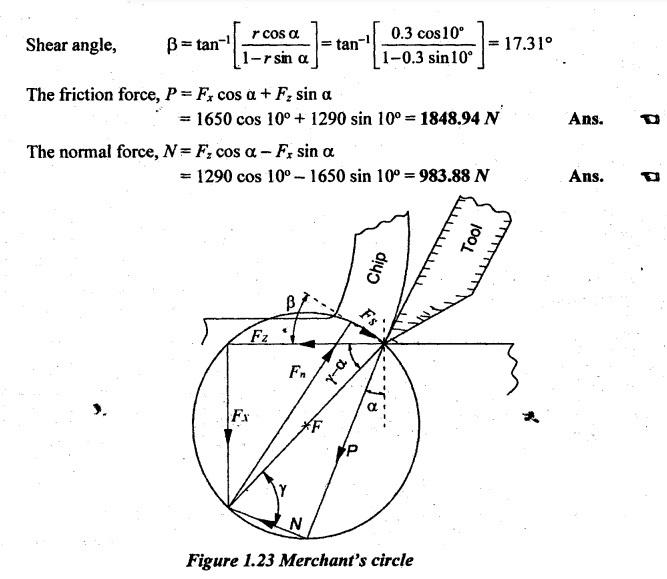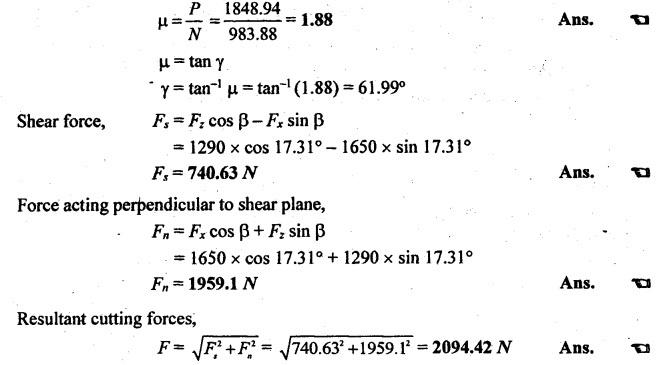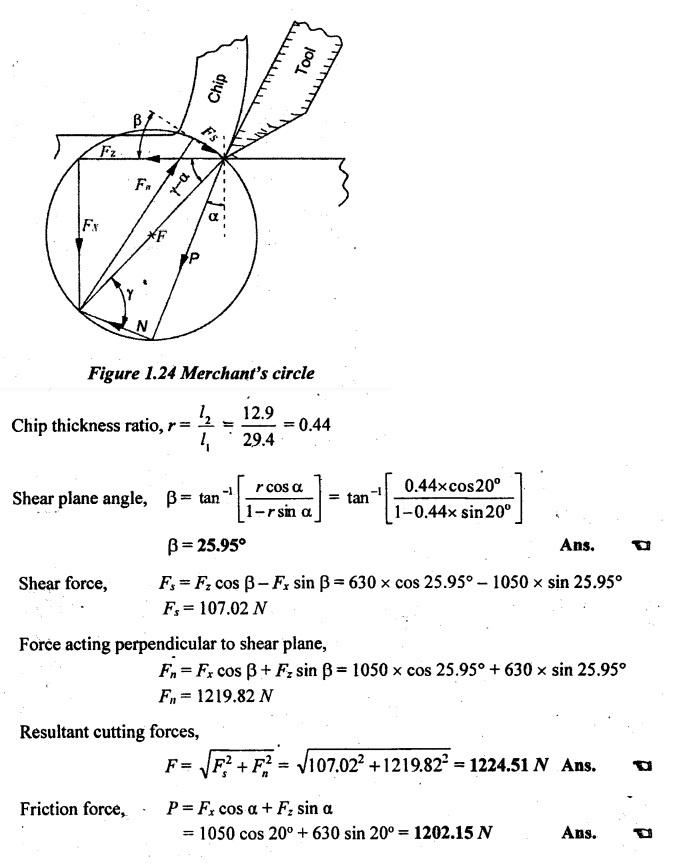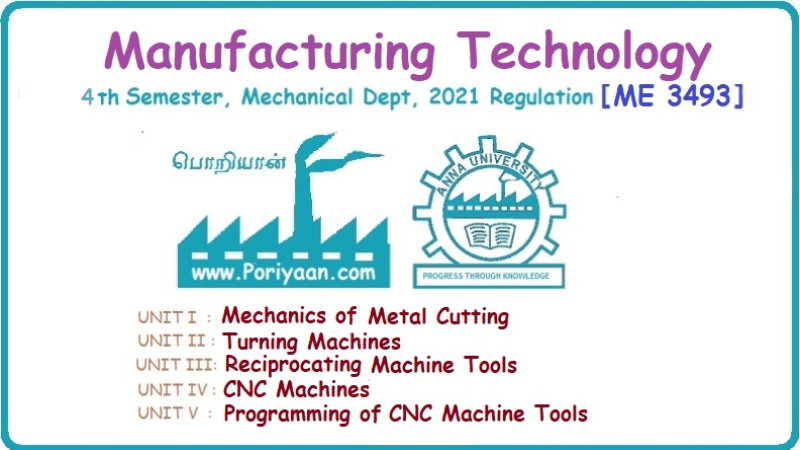Manufacturing Technology: Unit I: Mechanics of Metal Cutting
solved anna university problems on cutting forces
Mechanics of Metal Cutting - Manufacturing Technology
solved anna university problems on cutting forces: Mechanics of Metal Cutting - Manufacturing Technology
SOLVED ANNA UNIVERSITY PROBLEMS ON CUTTING FORCES AU Problem 1.1 The following data pertain to an orthogonal cutting test. Determine the forces on the tool face. Rake angle = 15° Uncut chip thickness = 0.38 Chip thickness ratio = 0.5 mm Width of cut = 3 mm Yield stress of metal in shear = 280 N/mm2. Coefficient of tool-chip friction = 0.7. Similar to Problem 1.5 on Page 1.39. [Ans:- Shear force, Fs = 1113.96 N, Resultant force, F = 1502.53 N, Tangential force or cutting force, Fz = 1411.0 N, Radial force (or) Feed force, Fx = 513.89 N and Normal force or feed force, N = 1230.78 N] AU Problem 1.2 During machining C20 steel with a carbide cutting tool having a tool geometry given by 0-5-6-6-8-75-1 mm ORS, the following forces have been recorded by a two dimensional dynamometer: Cutting force = 1300 N Feed force = 800 N Determine the following: Radial component of force, frictional force and normal force and kinetic coefficient of friction μ Given data: Rake angle, α = 5° Side cutting angle, γ = 75° Fz = 1300 N Fx = 800 N Solution: Normal force, N = Fz cos α - Fx sin α AU Problem 1.3 In orthogonal cutting operation, the tool has a rake angle = 15°. The chip thickness before the cut = 0.3 mm and the cut yields a deformed chip thickness = Calculate the (1) shear plane angle and (2) shear strain for the operation. Given data: α = 15° t1 = 0.3 mm t2 = 0.65 mm Solution: AU Problem 1.4 In an orthogonal cutting test with a tool of rake angle 10o, the following observations were made: Chip thickness ratio = 0.3 Horizontal component of cutting force = 1290 N Vertical component of cutting force = 1650 N From Merchant's theory, calculate the various components of the cutting forces and the coefficient of friction at the chip tool interface. Given data: α = 10° Fz = 1290 N Fx = 1650 N r = 0.3 Solution: Coefficient of friction at chip-tool interface AU Problem 1.5 In an orthogonal cutting test with a tool of rake angle 8o, the following observations were made: Chip thickness ratio = 0.2 Horizontal component of the cutting force = 1190 N Vertical component of the cutting force = 1450 N From Merchant's theory, calculate the various components of the cutting forces and the coefficient of friction at the chip tool interface. Similar to AU Problem 1.4 on Page 1.54. [Ans:- P = 1601.51 N, N = 976.62N, Fs = 876.45 N, Fn = 1658.44 N and F = 1875.79 N] AU Problem 1.6 A specimen of 100 mm length along the stroke of shaper is machined with a tool with 15o rake angle. The uncut chip thickness is 1.5 mm. If a chip length of 40 mm is obtained during one stroke of machining, find the shear plane angle and thickness of cut-chip. Similar to Problem 1.2 on Page 1.37. [Ans:- Shear angle, β = 23.3° and chip thickness, t2 = 3.75 mm] AU Problem 1.7 The following data was obtained from an orthogonal cutting test. Rake angle = 20o, depth of cut 6 mm, feed rate = 0.25 mm/rev, cutting speed = 0.6 m/s, chip length before cutting - 29.4 mm, vertical cutting force = 1050 N, horizontal cutting force = 630 N, chip length after cutting = 12.9 mm. Using Merchant's analysis, calculate the (i) magnitude of resultant force, (ii) shear plane angle, (iii) friction force and friction angle and (iv) various energies consumed. Given data: α = 20° d = 6 mm t1 = 0.25 mm/rev. V = 0.6 m/s l1 = 29.4 mm l2 = 12.9 mm Fx = 1050 N Fz = 630 N Solution: From Merchant's diagram, normal force can be calculated by Coefficient of friction at chip-tool interface is calculated by







Manufacturing Technology: Unit I: Mechanics of Metal Cutting : Tag: : Mechanics of Metal Cutting - Manufacturing Technology - solved anna university problems on cutting forces
Related Topics
Related Subjects
Manufacturing Technology
ME3493 4th semester Mechanical Dept | 2021 Regulation | 4th Semester Mechanical Dept 2021 Regulation
